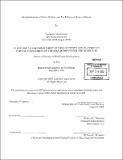Decentralization of office markets and the effects on rates of return
Author(s)
Garner, Laurence Alan, 1968-
DownloadFull printable version (4.033Mb)
Other Contributors
Massachusetts Institute of Technology. Dept. of Urban Studies and Planning.
Advisor
William C. Wheaton.
Terms of use
Metadata
Show full item recordAbstract
Does decentralization of office markets effect investment rates of return? This is the central hypothesis behind this research paper. In order to study the influence of decentralization of office markets on investment returns, this thesis uses three different sources of data. First, Torto Wheaton Research has supplied data which measures the quantity of office space in 43 MSAs throughout the United States. The data is organized in such a way that allows for the measurement of centralization for each MSA in 1980 and in 2001. Each MSA is assigned a centralization value which measures the degree to which its office market is centralized. The two points in time for which the data is supplied allow for the measurement of two centralization values and the degree of change of centralization for the MSA over the 21-year period. The quantity of office space in square feet for each MSA is also measured at both points in time as is the amount of change in each MSA's market size. Second, values for population centralization in 1996 are created. The first section of the research regresses current office centralization values against past office centralization values, the change in office centralization over 21 years, the market size at both points in time, the change in market size over 21 years and the value for population centralization. The purpose of this first section is to better understand the influence of these other variables on office centralization. This understanding provides a foundation for the second part of the research. In the second part of the research, investment returns for office space of institutional investors are regressed against the office and population centralization values created in the first part of the research. The thesis finds that decentralization is not a significant determinant of investment rates of return for the general office market (MSA Office), however, there is a weak connection with suburban markets. The research indicates that investment returns are highest when population is decentralized and office space is centralized.
Description
Thesis (S.M.)--Massachusetts Institute of Technology, Dept. of Urban Studies and Planning, 2002. Includes bibliographical references (leaves 77-78).
Date issued
2002Department
Massachusetts Institute of Technology. Department of Urban Studies and PlanningPublisher
Massachusetts Institute of Technology
Keywords
Urban Studies and Planning.